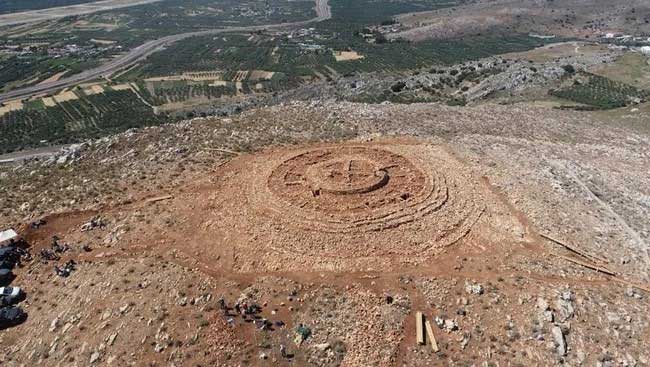Archaeologists report that a 4,000-year-old circular structure discovered on a hilltop in Greece may have been used for ancient Minoan rituals.
The structure consists of eight stacked stone rings with intersecting low walls that create chambers, making the building almost a labyrinth, according to a statement from the Greek Ministry of Culture on June 11, referencing the legendary labyrinth constructed for King Minos of Greece.

Overview of the 4,000-year-old structure recently discovered on a hilltop in Kastelli, Greece. (Photo source: Greek Ministry of Culture)
The unique structure has a diameter of 48 meters and was found about 51 kilometers southeast of Heraklion, the capital of Crete, while construction workers were installing a monitoring radar system for a new airport. Located atop a hill near the town of Kastelli, the ancient building appears to consist of two main areas: a circular building 15 meters in diameter at its center and an area formed by radiating walls.
Based on the shape of pottery shards discovered during the excavation, archaeologists estimate that the building dates back to between 2000 and 1700 BC, during the height of Minoan civilization. Between 3000 and 1100 BC, the Minoans developed one of the first complex cultures in Europe on the island of Crete, leaving behind examples of pottery, figurines, jewelry, and exquisite frescoes.
After the collapse of this civilization, the Minoans were largely forgotten until archaeological work in the early 20th century by Sir Arthur Evans, who coined the term “Minoan” after the mythical king Minos.
The ancient Palace of Knossos is the most famous example of Minoan architecture, featuring an open central space surrounded by dozens of smaller rooms interconnected by corridors. Although often referred to as a “palace,” these massive architectural structures of the Minoans primarily served as areas for local administrative activities rather than royal residences.
According to the Ministry of Culture’s statement, the newly discovered building near Kastelli is also unlikely to have been used as a residence. Rather, the presence of numerous animal bones among other findings suggests that the building was periodically used for community-wide ceremonial feasts that included food, wine, and other offerings.




















































